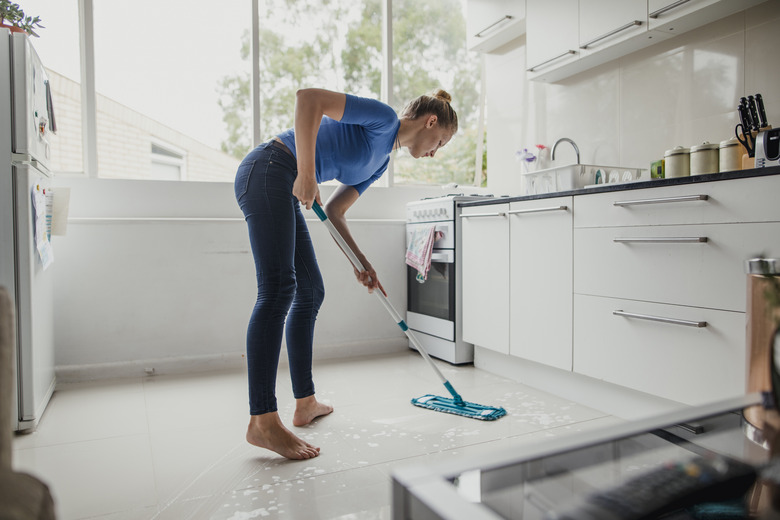Tips On Using Mop & Glo
Mop & Glo is designed to be used on slick vinyl floors and works wonders on linoleum and no-wax types of flooring that are often found in kitchens, bathrooms and laundry rooms. Although it is a powerful cleaning agent that can whisk dirt away from your floors while leaving behind an enviable high shine, using the product repeatedly can lead to a waxy, dingy build-up that is difficult to remove.
Mop & Glo also inadvertently gets used on floors for which it is not intended, often with adverse results. However, by understanding these nuances before you use Mop & Glo, you can save yourself time and effort later.
Where Mop & Glow Won’t Shine
Where Mop & Glow Won't Shine
There are some obvious flooring types that would make someone pause before putting Mop & Glo over the surface, such as antique hardwood floors.
Natural flooring types that aren't recommended for the use of this type of cleaner and shining agent include bamboo, mahogany, cherry and most hardwoods. It will leave a whitish, cloudy film over the top of hardwood floors and make them appear even dirtier than when you started.
Ingredients in Mop & Glo
Ingredients in Mop & Glo
Mop & Glo is a water-based acrylic polymer polish, which makes it an effective cleaner and shining agent. The ingredients in Mop & Glo include:
- Water
- Modified acrylic polymer
- Trideceth-3 as a surfactant along with partially fluorinated alcohol, ammonium
salts and phosphorous oxide as reaction products - Ethoxydiglycol as a solvent
- Oxidized polyethylene
- Maleic modified rosin resin
- Zinc oxide
- Fragrance
- Ammonium hydroxide as a pH adjuster
Always test Mop & Glo in an area that is out of the way before applying it to any type of flooring to ensure the chemicals in the product don't react negatively to your type of flooring.
How to Remove Mop & Glo Build-up
How to Remove Mop & Glo Build-up
If your floors are yellowish and discolored, then removing the layers of the cleaner and shining agent takes a strong detergent stripper and copious amounts of elbow grease. You may need to repeat the stripping process a few times to completely remove the cleaner and protective coating of Mop & Glo.
Ammonia is a good go-to to get rid of Mop & Glo build-up. To use ammonia on its own without any additional soapy detergents, add ¼ cup of ammonia to a gallon of water. Mop the mixture over your floors and remove it with a clean, dry mop head.
You may also add a half of a cup of general-purpose cleaner that doesn't have bleach in its ingredient list and 2 cups of ammonia to a gallon of warm water. Work in small sections across the floor to an entryway. For corners and indents on the floor, a hand-held brush with stiff bristles is more effective than a long-handled mop.
Shark Steam Mop Cleaning Solution
The Shark Steam Mop has a good cleaning solution that is sold by the company and creates a powerful cleaner when paired with hot steam.
A homemade steam mop cleaner detergent, such as equal parts water, vinegar and rubbing alcohol with a few drops of dish soap, can also be paired with the steam to work on difficult dirt and grime on floors. Simply put it in the reservoir where you pour in the water.
You can use the steam mop on a linoleum floor but with great precaution. The head of a steam mop can heat up very quickly. This benefit of the steam mop can also create problems for no-wax and linoleum flooring. If left too long on one area, the mop head can heat up the flooring's covering and leave a white spot.
